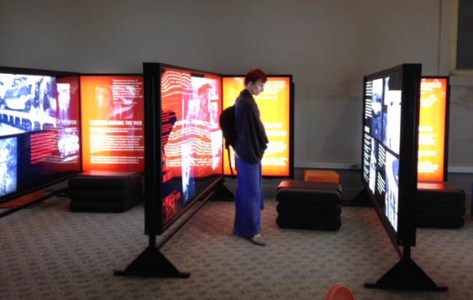
Japanese American National Museum. Gift of June Hoshida Honma, Sandra Hoshida, and Carole Hoshida Kanada.
Not long after the Japanese bombed Pearl Harbor in 1941, George Hoshida was arrested by FBI agents. Having immigrated from Japan with his family in 1912, when he was only four years old, Hoshida had made a life for himself in Hilo, Hawai‘i. He had married a Hawai‘i–born Japanese American woman named Tamae and gotten a job at the Hilo Electric Company; he had also become active in several Japanese American community organizations, including a Buddhist group and a judo association. It was Hoshida’s position in the community and his perceived influence on others that led authorities to deem him a threat.
Hoshida was forcibly separated from his wife and four daughters as he was sent to a succession of special Justice Department camps, reserved for community leaders like himself: Kilauea Military Camp on the Big Island, Sand Island on Oahu, and a variety of camps in Texas, Nevada, and New Mexico. After a year of separation, Tamae, who was handicapped, found it too difficult to raise the children without George. She made the decision to give up their home and, on the recommendation of government officials, moved with three of their daughters to the Jerome War Relocation Center in Arkansas, where George could be transferred.

Arriving there after an arduous journey, the family would have to wait another year before George’s transfer process could be completed. Tragically, the eldest daughter, who had to be left behind in a facility in Oahu due to a handicap, died while the rest of the family was incarcerated.
During this challenging time, Hoshida and his wife wrote letters to each other every day. Hoshida also kept a detailed journal and made numerous sketches, drawings, and watercolors depicting what he saw around him. These letters, journal entries, and artworks are now considered a rare record of life in the Justice Department camps; the depictions of the Kilauea camp are the only ones known to exist. In 1997, the bulk of these artifacts were donated to JANM, where they now reside in the permanent collection. Many of the items can be viewed online through JANM’s George Hoshida Collection page as well as a special online exhibition website called The Life and Work of George Hoshida: A Japanese American’s Journey.

Japanese American National Museum. Gift of June Hoshida Honma, Sandra Hoshida, and Carole Hoshida Kanada.
Earlier this year, a new book was published that tells the Hoshida family’s story through a curated selection of Hoshida’s journal entries, memoir excerpts, letters, and artworks. Edited by Heidi Kim and supplemented with historical background information, Taken from the Paradise Isle: The Hoshida Family Story provides “an intimate account of the anger, resignation, philosophy, optimism, and love with which the Hoshida family endured their separation and incarceration during World War II.”
The hardcover edition of the book is already sold out; the JANM Store and janmstore.com are currently waiting on an order of the paperback edition. The book should be restocked in time for an author discussion event on January 9, in which Heidi Kim will read from and discuss the book. To read more about the Hoshida family’s story, check out this Discover Nikkei article.

























